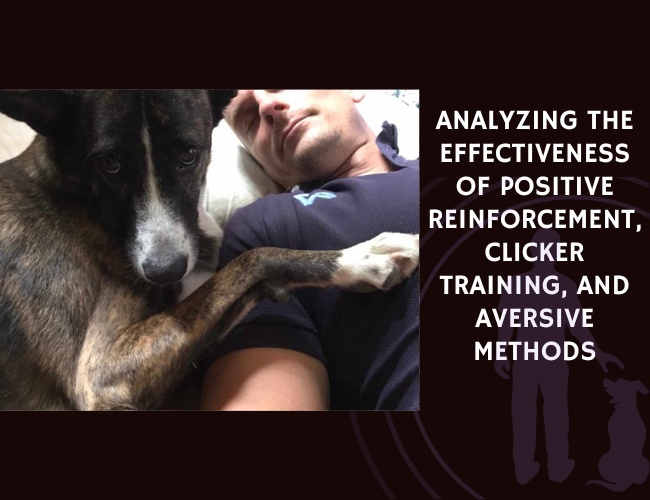Introduction to Modern Dog Training Methods
Overview of Different Training Approaches in Contemporary Dog Training
Dog training has undergone significant transformations over the years, evolving from traditional methods that relied heavily on compulsion and punishment to more humane and scientific approaches. Contemporary dog training encompasses a wide variety of techniques. Some of the most common methods include positive reinforcement, clicker training, and aversive training. Each method has its philosophies, benefits, and downsides, which trainers and dog owners must carefully consider.
Evolution from Traditional to Evidence-Based Training Methods
Historically, dog training methods were dominated by aversive techniques, often termed as “traditional methods.” These involved the use of physical corrections such as leash jerks, collar tightening, and other forms of punishment intended to suppress unwanted behavior. However, these methods were gradually criticized for their ethical concerns and potential harm to dogs’ welfare.
The shift towards evidence-based training began with the growing body of research in animal behavior and psychology. This transition was marked by the introduction of positive reinforcement techniques, which emphasize rewarding desired behaviors rather than punishing unwanted ones. Pioneering work by behaviorists like B.F. Skinner laid the groundwork for this paradigm shift by demonstrating the effectiveness of reinforcement in behavior modification.
Evidence-based training methods are now supported by a substantial amount of scientific research, which underscores their efficacy and benefits. These methods prioritize the dog’s well-being and are designed to foster a positive and trusting relationship between the dog and the handler.
Importance of Scientific Research in Determining Training Effectiveness
Scientific research plays a crucial role in modern dog training, providing empirical data that informs best practices. Studies have shown that positive reinforcement and reward-based training approaches lead to more reliable and consistent behavior in dogs. Research also highlights the drawbacks of aversive methods, which can increase stress, anxiety, and aggressive behaviors in dogs.
For instance, research conducted by the American Veterinary Society of Animal Behavior (AVSAB) has consistently shown that dogs trained with positive reinforcement exhibit fewer behavioral issues than those trained with punishment-based methods. Additionally, neuroscience research has demonstrated how the release of dopamine, the “feel-good” hormone, is associated with reward-based training, promoting better learning and memory retention in dogs.
Moreover, the ongoing advancements in the field of animal cognition have provided deeper insights into how dogs learn and process information. This knowledge facilitates the development of training methods that are not only effective but also aligned with the natural learning processes of dogs.
The importance of scientific research extends beyond just the mechanics of training. It also influences the ethical considerations of dog training practices. By grounding training methods in scientifically validated principles, trainers can ensure they are employing humane and respectful techniques that prioritize the dog’s mental and physical well-being.
As contemporary dog training continues to evolve, the integration of scientific research remains a cornerstone. This approach not only improves training outcomes but also fosters a more compassionate and understanding human-animal relationship.
Taking a closer look at the effectiveness and methodologies of specific training techniques will further unravel the nuances in modern dog training. The following sections will delve into positive reinforcement training, clicker training, and aversive methods, revealing the comparative benefits and impacts on our canine companions.
Understanding Positive Reinforcement Training
Scientific Basis of Positive Reinforcement in Behavioral Modification
Positive reinforcement training revolves around the principles of operant conditioning, a concept developed by B.F. Skinner. In operant conditioning, behavior is influenced by the consequences that follow it. Positive reinforcement specifically entails the addition of a rewarding stimulus following a desired behavior, increasing the likelihood that the behavior will be repeated. This approach is grounded in extensive scientific research which demonstrates that behavior reinforced with positive stimuli tends to be more consistent and reliable.
Behavior modification through positive reinforcement is rooted in the brain’s reward system. The release of dopamine, a neurotransmitter associated with pleasure and reward, strengthens the connection between the behavior and the consequent positive outcome. This neurological response not only enhances learning but also promotes a stronger emotional bond between the dog and the handler, creating a more positive training atmosphere.
Benefits of Reward-Based Training Approaches
There are several significant advantages to using positive reinforcement training methods:
- Improved Learning Outcomes: Dogs trained with positive reinforcement are more motivated to learn and exhibit a higher level of engagement during training sessions. The desire for rewards such as treats, play, or affection promotes focused and enthusiastic participation.
- Reduced Behavioral Issues: Positive reinforcement helps in redirecting undesired behaviors by encouraging and rewarding alternative, appropriate actions. As a result, it can effectively diminish issues such as aggression, anxiety, and fear.
- Stronger Bond: The use of rewards fosters trust and deepens the relationship between the dog and the handler. This positive interaction makes the training process more enjoyable for both parties, enhancing mutual respect and cooperation.
- Ethical Considerations: Adopting reward-based methods aligns with modern views on animal welfare, as it avoids the use of harsh punishments or physical coercion. This method ensures the humane treatment of dogs throughout the training process.
Role of Consistency and Timing in Positive Reinforcement
Consistency and timing are pivotal elements in the effectiveness of positive reinforcement training.
- Consistency involves uniformly applying the same standards and rewards for specific behaviors. This predictability ensures that dogs understand what is expected of them, leading to quicker and more reliable learning. Inconsistent reinforcement can confuse the dog, resulting in slower progress and frustration.
- Timing is crucial because the reward must be presented immediately after the desired behavior occurs. This immediacy ensures that the dog associates the positive outcome directly with the action performed, solidifying the behavior in the dog’s memory. Delayed reinforcement diminishes this connection and can inhibit the learning process.
Implementing these principles of consistency and timing can greatly enhance training sessions. For instance, using a clicker or a marker word followed immediately by a reward can help in creating clear communication and expectations.
Positive reinforcement training, with its scientific backing and numerous benefits, stands out as an effective and ethical approach to modifying dog behavior. The emphasis on rewarding desired behaviors not only improves learning outcomes but also fosters a positive and trustful relationship between dogs and their handlers, aligning with modern perspectives on animal training and welfare.

Clicker Training: Methodology and Effectiveness
Principles and Mechanics of Clicker Training
Clicker training is an evidence-based technique that leverages the principles of operant conditioning, a concept developed by B.F. Skinner. This method uses a small handheld device, known as a clicker, to deliver a distinct and consistent sound when the dog performs a desired behavior. The sound of the clicker acts as a secondary reinforcer, signaling to the dog that they have done the correct behavior and a reward is forthcoming.
The mechanics of clicker training involve three main components:
- Timing: It is crucial to click at the exact moment the desired behavior occurs. This precision helps the dog clearly understand which behavior is being rewarded.
- Consistency: The clicker sound must be consistent every time it is used. Any variation can confuse the dog and reduce the effectiveness of the training.
- Reinforcement: Positive reinforcement follows the click. This usually involves giving the dog a small treat, but toys, praise, or play can also be effective rewards.
By consistently pairing the click with a reward, dogs quickly learn to associate the sound with positive outcomes, leading to faster learning and better retention of behaviors.
Comparison with Other Training Methods Including ‘Do as I Do’
Compared to traditional methods, clicker training is more precise and can yield faster results. A noteworthy alternative to clicker training is the ‘Do as I Do’ (DAID) approach. DAID harnesses social learning, where dogs are trained to imitate human actions, then apply these actions to new contexts following verbal commands.
While DAID can be effective and engaging, particularly for dogs that are naturally inclined to mimicry, it requires the dog to be already capable of understanding more complex cognitive commands. In contrast, clicker training is relatively simpler and can be applied to a wide range of behaviors without needing the dog to exhibit imitative behavior inherently.
Research Findings on Clicker Training Effectiveness Versus Traditional Methods
Numerous studies have demonstrated the superiority of clicker training over traditional methods that often involve aversive techniques. Research indicates that dogs trained with clickers learn new behaviors more rapidly and retain those behaviors longer than dogs trained with punishment-based methods.
Additionally, one notable study found that dogs trained using clickers were more enthusiastic and engaged in training sessions compared to those trained with conventional methods, which often used corrections or punishment. The use of a clicker reduces the ambiguity around what behavior is being rewarded, making the training process clearer and more enjoyable for the dog.
Moreover, clicker training supports a positive emotional state in dogs, reducing stress and anxiety that are often associated with aversive methods. This fosters a more robust and trustful human-animal bond, which is critical for overall training success and the well-being of the dog.
Clicker training’s emphasis on positive reinforcement aligns with modern understanding of animal behavior and welfare. It supports a humane and effective approach to training, reinforcing the shift from traditional punishment-based methods toward a more evidence-based and ethical practice.
Understanding the principles, benefits, and empirically backed success of clicker training provides a foundation for adopting training methods that prioritize the welfare and learning efficiency of our canine companions. The next step involves more in-depth comparisons of positive reinforcement and aversive methods to highlight the most effective and ethical approaches to dog training.
Examining Aversive Training Methods
Examining aversive training methods is critical to understanding their impact on dog welfare and behavior. Aversive methods, also known as punishment-based training, involve applying negative stimuli or corrections to reduce unwanted behaviors. This approach contrasts sharply with modern, evidence-based methods like positive reinforcement and clicker training.
Negative Impacts on Dog Welfare and Behavior
Aversive training methods often lead to several negative outcomes in dogs. When punished, dogs may not comprehend the reason behind the correction, causing confusion and anxiety. This misunderstanding can manifest as increased aggression, fearfulness, and avoidance behaviors. For example, a dog subjected to harsh leash corrections may become fearful of walking on a leash altogether.
Punishment-based training also undermines the dog-handler relationship. Trust, which is essential for effective training and a healthy bond, is eroded when dogs experience pain or discomfort from their handlers. This mistrust can result in dogs becoming less motivated to engage in training, directly affecting learning outcomes and overall behavior.
Research Findings on Stress and Anxiety
Several research studies have documented the stress and anxiety induced by aversive training. Physiological indicators such as elevated cortisol levels and increased heart rates have been observed in dogs subjected to punishment-based methods. These stress indicators correlate with evident behavioral signs of distress, like cowering, lip licking, and excessive panting.
Chronic stress due to aversive training methods can have long-term health implications for dogs. Persistent anxiety not only diminishes a dog’s quality of life but can also weaken immune function and exacerbate medical conditions.
Long-Term Behavioral Consequences
The long-term behavioral consequences of punishment-based training are severe. Dogs trained with aversive methods are more prone to develop anxiety disorders and display undesired behaviors such as fear-based aggression. The immediate suppression of behavior through punishment does not address the underlying causes of the behavior, often resulting in a resurgence of the problem behavior once the aversive stimulus is removed.
Moreover, the generalization of fear caused by aversive training can extend beyond the training context, affecting other areas of the dog’s life. A dog that experiences punishment for barking at strangers may start to show generalized anxiety towards all unfamiliar people or situations, severely limiting their ability to cope with everyday life.
Integrating Evidence-Based Insights
The insights drawn from examining aversive training methods strongly advocate for the use of evidence-based, humane approaches in dog training. Recognizing the negative impacts of punishment on welfare and behavior underscores the importance of using techniques that promote positive relationships, trust, and long-term behavioral health in dogs.
Understanding these dynamics helps in making informed decisions when choosing training methods, encouraging the adoption of practices that are both effective and compassionate towards our canine companions.

Comparative Analysis of Training Methods
Research-Based Comparison of Positive Reinforcement Versus Aversive Methods
When comparing positive reinforcement with aversive training methods, scientific research overwhelmingly supports the former as more effective and humane. Positive reinforcement, a technique rooted in rewarding desired behaviors, has shown significantly better outcomes in fostering reliable and sustainable behavior changes in dogs. This method is predicated on the principles of operant conditioning, which have been extensively validated through empirical studies.
Aversive methods, in contrast, hinge on using punishment or negative stimuli to reduce unwanted behaviors. While such techniques may yield immediate compliance, research indicates they often lead to detrimental long-term effects on a dog’s well-being and behavior. Punishment-based methods frequently result in dogs experiencing elevated levels of stress, anxiety, and fear. These negative emotional states can undermine the dog-handler relationship and ultimately be counterproductive, causing further behavioral issues.
Impact of Different Training Approaches on Learning Outcomes and Dog Behavior
The influence of training methods on learning outcomes and dog behavior is profound. Positive reinforcement facilitates faster learning and retention of new behaviors. Dogs trained through reward-based methods exhibit greater enthusiasm and willingness to engage in training sessions. This approach not only makes the training process enjoyable for dogs but also strengthens the bond between dogs and their handlers, promoting a trusting relationship.
Conversely, aversive training methods can have the opposite effect. The use of punitive measures, such as choke collars or physical reprimands, has been shown to induce fear and aggression in dogs. Studies highlight that dogs subjected to aversive techniques are more likely to develop anxiety-related behaviors and reactive aggression. These adverse effects can significantly hinder the overall learning process and lead to an increase in behavioral problems over time.
Role of Owner Engagement and Consistency in Training Success
Owner engagement and consistency are vital aspects of successful dog training, irrespective of the methods employed. Positive reinforcement training benefits greatly from active owner participation and consistent application of rewards. The timely delivery of rewards following a desired behavior is critical to reinforcing the connection between the behavior and the reward. Consistency in this approach ensures that the behavior is reliably reinforced and more likely to be repeated.
The role of the owner is equally important when aversive methods are used, although the outcomes are less favorable. Consistency in punishment-based training can often reinforce fear and mistrust, leading to a strained relationship between the dog and its owner. The unpredictability associated with aversive techniques can confuse dogs, making them anxious and exacerbating behavioral issues.
Conclusion
The comparative analysis of positive reinforcement and aversive training methods underscores the superiority of the former in achieving desirable learning outcomes and fostering positive behavior in dogs. The impact of training methods on a dog’s emotional well-being and the crucial role of owner engagement and consistency cannot be overstated. As we advance in understanding effective training, it is imperative to base our methods on scientific evidence to ensure the well-being and success of both the dogs and their handlers.
What is the Most Effective Method of Dog Training?
When evaluating the most effective method of dog training, positive reinforcement consistently emerges as the leading approach. This method, grounded in the principles of operant conditioning, focuses on rewarding desired behaviors to encourage their repetition. Scientific research supports the efficacy of positive reinforcement, highlighting its ability to foster reliable and consistent behavior changes in dogs. Unlike aversive methods, which rely on punishment and can lead to stress and anxiety, positive reinforcement promotes a positive emotional state, enhancing the learning experience for dogs.
Positive reinforcement not only improves learning outcomes but also strengthens the bond between dogs and their handlers. By using rewards such as treats, praise, or play, trainers can create an engaging and enjoyable training environment. This approach aligns with modern animal welfare standards, ensuring that training is both humane and effective. The emphasis on rewarding desired behaviors rather than punishing unwanted ones makes positive reinforcement a preferred choice among trainers and dog owners alike.
In contrast, aversive training methods, which involve negative stimuli to suppress undesired behaviors, have been shown to compromise dog welfare. Studies indicate that these methods can increase stress levels and lead to behavioral issues such as aggression and fearfulness. As a result, many experts advocate for the use of positive reinforcement as the most effective and ethical method of dog training. By prioritizing the well-being of dogs and fostering a trusting relationship, positive reinforcement sets the foundation for successful and sustainable behavior modification.
Practical Implications and Recommendations
Guidelines for Choosing Appropriate Training Methods
Selecting the right training method for your dog is crucial to ensure effective learning and a healthy relationship between you and your pet. Positive reinforcement training, which focuses on rewarding desired behaviors, should be the go-to approach for most dog owners. This method is backed by extensive scientific research, demonstrating that it is both humane and effective. It involves rewarding your dog with treats, praise, or play whenever they exhibit the desired behavior.
- Evaluate Your Dog’s Needs: Every dog is unique. Consider their age, breed, temperament, and past experiences when choosing a training method. Puppies, for instance, need short and fun training sessions, whereas adult dogs might benefit from more structured routines.
- Consider Your Goals: Your training goals can influence the method you choose. If you’re working on basic obedience, positive reinforcement can quickly establish these behaviors. For more complex tasks, clicker training might provide the precision needed.
- Seek Professional Advice: If you’re unsure about the best approach, consult with a professional dog trainer or veterinarian. They can provide insights tailored to your dog’s specific needs.
- Be Informed About Methods: Educate yourself on various training techniques and their effectiveness. Avoid methods that involve punishment or aversive techniques, as these can cause long-term harm to your dog’s well-being.
Importance of Tailoring Approaches to Individual Dogs
Training methods should not be one-size-fits-all. It’s essential to consider the unique characteristics of each dog to achieve optimal results. Factors like a dog’s energy level, anxiety, sociability, and previous training experiences can significantly influence which methods will be most effective.
- Assess Behavioral Traits: Dogs with high energy levels may benefit from active training sessions with lots of physical activity. In contrast, more reserved dogs might respond better to gentle guidance and encouragement.
- Adjust for Sensitivity: Some dogs are more sensitive to noise or physical touch. In these cases, softer spoken commands and non-intrusive hand signals can be more effective than louder, more assertive techniques.
- Monitor Progress and Adjust: Continuous assessment of your dog’s response to the training is crucial. If a particular method isn’t yielding the desired results, be flexible and adjust your approach. This might mean switching to a different reward system or trying shorter training sessions.
Best Practices for Implementing Evidence-Based Training Methods
Implementing evidence-based training methods involves understanding and applying the principles of learning theory in practical, consistent ways.
- Consistency is Key: Ensure that all family members or anyone involved in your dog’s training are consistent in their commands, cues, and rewards. Inconsistent signals can confuse the dog and slow down the learning process.
- Timing Matters: Immediate reinforcement of desired behaviors is essential. The quicker the reward is given after the correct behavior, the stronger the association the dog makes between the behavior and the reward.
- Stay Patient and Positive: Training should be a positive experience for both you and your dog. Maintain a calm and patient demeanor, and avoid showing frustration. Positive training is about building a trustworthy relationship.
- Use High-Value Rewards: Identify what your dog values most, whether it is a particular treat, toy, or affection. High-value rewards can greatly enhance the effectiveness of your training efforts.
- Keep Sessions Short and Engaging: Especially for younger dogs or those new to training, keep sessions short but frequent. Dogs have limited attention spans, and shorter, engaging sessions are more productive than long, tedious ones.
- Regularly Review Progress: Periodically review and assess your dog’s progress to keep track of what is working and what isn’t. This will help you make necessary adjustments and ensure continued advancement in your dog’s training.
Using these practical guidelines will help in the successful implementation of evidence-based training methods, fostering a positive, effective, and humane approach to dog training that benefits both the dog and the owner.


 Looking to go deeper into dog training?
Looking to go deeper into dog training? Dog Behavior
Dog Behavior Dog Training
Dog Training Dog Nutrition
Dog Nutrition Health & Wellbeing
Health & Wellbeing Dog Entertainment
Dog Entertainment Dog Breeds
Dog Breeds Who is my Dog
Who is my Dog






